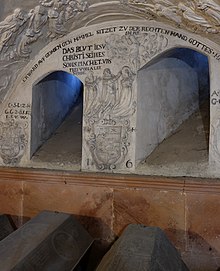Philip III (Hessen-Butzbach)


Philip III von Hessen-Butzbach (born December 26, 1581 in Darmstadt ; † April 28, 1643 ) was Landgrave of Hessen-Butzbach from 1609 to 1643 .
Life
His parents were Georg I (Georg the Pious) of Hessen-Darmstadt (* 1547; † 1596) and Magdalena zur Lippe (* 1552; † 1587). Philipp's first wife was Anna Margaretha von Diepholz , she died childless in 1629 and was buried in the town church in Butzbach . His second wife, Christina Sophia von Ostfriesland (* 1609 in Aurich, † 1658 in Frankfurt am Main ), he married in Aurich in 1632 .
When his father died in 1596, the country was divided into three parts. In Hessen-Darmstadt , as in many princely courts, the right of birthright (primogeniture right) applied. The first-born son became his successor, and the others were settled with money. However, when there was a lack of money, parts of the land were given to the younger ones and their personal belongings were cut. They also called themselves landgraves , but sovereign rights remained with the firstborn. The main mass, the upper county, fell to the eldest son, Ludwig V the Faithful (1596–1626). The younger, Friedrich , the founder of the Homburg line, received Homburg am Taunus , Philipp was resigned to Butzbach.
The Landgraviate of Butzbach initially only consisted of the city of Butzbach and a few villages in the neighborhood. The Solms-Braunfels' last quarter was not yet one of them. During the Thirty Years' War this part also passed to the Landgrave because the Count of Solms-Braunfels had fallen out of favor with the Kaiser. In 1639, the Itter rule in Waldeck with the castle in Vöhl and the associated villages was added. For this, however, Philip was deducted 7,300 guilders of his annual personal property from 24,000 guilders.
The new Butzbach residence flourished in the middle of the Thirty Years War. Landgrave Philipp was a well-traveled and learned man. Within just four weeks he learned the basics of Hebrew, Syriac and “Chaldean” (Aramaic) from Julius Konrad Otto (born as Naphthali Margolith). Philipp spoke eight languages, was a mathematician and collected a valuable library. For astronomical studies he had an observatory built in his castle in Butzbach , acquired astronomical instruments and in 1618 hired the former Rosicrucian and doctor Daniel Mögling (alias Theophilus Schweighart ) as court mathematician and court astronomer , who came from a family of professors in Tübingen . Mögling, who had also translated Philip Sidney's Arcadia , was in contact with Wilhelm Schickard (1592-1635), who had become known as the inventor of the adding machine (1623). Through his studies, Philipp had relationships with the astronomers Kepler and Galilei .
During two trips to Italy in 1602 and 1607, the young landgrave met Galileo Galilei, 17 years his senior, and corresponded with him. The imperial astronomer Johannes Kepler (1571–1630) came to Butzbach twice - in July 1621 and October 1627. Together with Philipp, he made observations on the size of the sunspots, among other things . In 1624 Philipp Johannes Kepler had Chilias logarithmorum printed. Kepler's daughter Susanne was also a guest at the Butzbacher Hof from time to time.
Landgrave Philipp worried about the expansion of the residence and had a pleasure garden and tree garden created around his castle. After the castle barracks , which emerged from the castle in 1818 , were abandoned , the parks were partially restored. The greatest attraction was a planetary fountain , of which only drawings, a painting, descriptions and a modern model exist. On the Schlossberg above Munster he had the fortress-like Philippseck Castle built in 1626-28 , which served as a place of refuge in times of war and during the plague.
In 1643 Philip III died. during a sweat cure that had been prescribed for him by his doctor Johann Schröder a year earlier on a bathing trip to Ems . During one of these sweat cures, alcohol had ignited due to the carelessness of the body barber. A jet flame inflicted severe burns on the sick landgrave, from which he died a little later.
Philip's second marriage also remained childless. Therefore, after only one generation, the appanage fell back to Hessen-Darmstadt, the Landgraviate of Butzbach was dissolved after Philip's death. The Butzbacher Schloss remained the widow's seat of his second wife Christina Sophia until her death in 1658.
literature
- Katharina Schaal: Philipp III .. In: New German Biography (NDB). Volume 20, Duncker & Humblot, Berlin 2001, ISBN 3-428-00201-6 , p. 379 f. ( Digitized version ).
- Siegfried Rösch: Landgrave Philipp v. Hessen-Butzbach and his circle of scholars. Geneal. Jb., Volume 8. Degener, Neustadt a. Aisch 1968.
- Siegfried Rösch: Landgrave Philipp III. by Hessen-Butzbach and Johannes Kepler. Wetterauer Geschichtsblätter, Volume 24. Friedberg, Hessen 1975, pp. 99-108.
- Arthur Wyß : Philip III. In: Allgemeine Deutsche Biographie (ADB). Volume 26, Duncker & Humblot, Leipzig 1888, p. 1 f.
Web links
- Publications by and about Philip III. in VD 17 .
- Hessen-Darmstadt, Philipp Landgrave of. Hessian biography. (As of January 8, 2020). In: Landesgeschichtliches Informationssystem Hessen (LAGIS).
Individual evidence
- ^ Letter from the Butzbach pastor Johannes Dieterich (1572–1635) to his brother Konrad Dieterich in Ulm from May 1619. In: Wilhelm Martin Becker: From the learned proletariat of the post-Reformation period . In: Archiv für Kulturgeschichte 8 (1910), pp. 418–436, especially pp. 432–434.
| personal data | |
|---|---|
| SURNAME | Philip III |
| ALTERNATIVE NAMES | Hessen-Butzbach, Philipp III. from (full name) |
| BRIEF DESCRIPTION | Landgrave of Hessen-Butzbach (1609–1643) |
| DATE OF BIRTH | December 26, 1581 |
| PLACE OF BIRTH | Darmstadt |
| DATE OF DEATH | April 28, 1643 |
